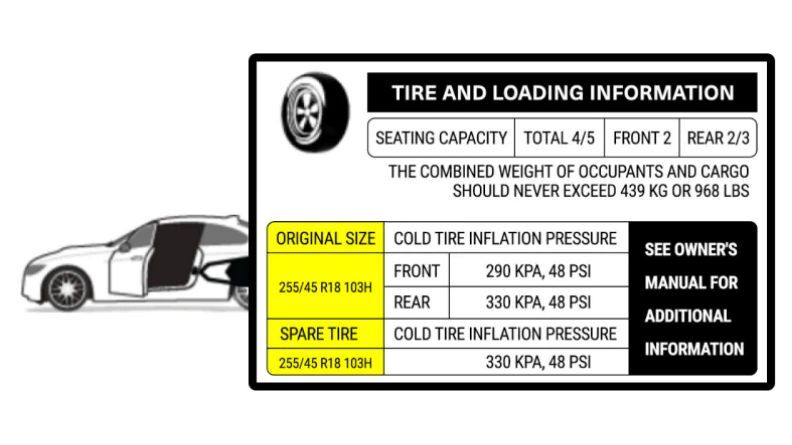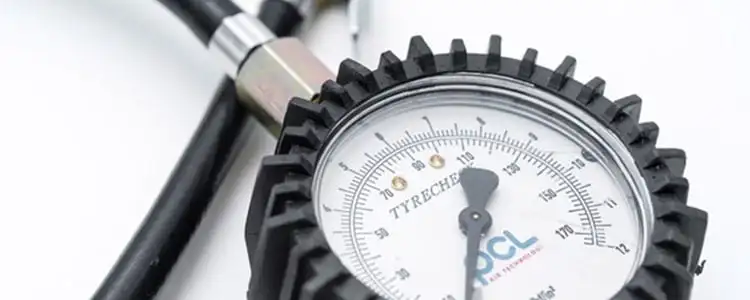Have you ever wondered about the right inflation pressure for your car tires? If you’ve noticed your car isn’t handling as smoothly as it should, or if you’re concerned about tire wear, you’re not alone.
Many drivers overlook the importance of tire pressure, but it’s a crucial aspect of vehicle maintenance. Understanding the common inflation pressure for car tires can save you money, keep you safe, and improve your driving experience. You’re about to discover how the right tire pressure can boost your car’s performance and fuel efficiency, ensuring you get the most out of every mile.
Stay with us as we dive into this essential topic, unraveling the secrets behind optimal tire pressure and what it means for you and your car.

Credit: www.carsales.com.au
Importance Of Tire Pressure
Tire pressure plays a crucial role in your car’s performance. Proper inflation leads to better handling and fuel efficiency. It also ensures safety on the road. Under-inflated tires can wear out faster and cause accidents. Regularly checking tire pressure saves you money and keeps you safe.
Maintaining the right tire pressure enhances driving comfort. It reduces the risk of tire blowouts. Correct inflation extends the life of your tires. It ensures your car grips the road effectively. Tire pressure affects fuel consumption directly. Lower pressure increases rolling resistance. This results in higher fuel usage. Inflated tires reduce emissions and save the environment.
Safety Concerns
Driving with low pressure is risky. It compromises your control over the vehicle. The car may skid in wet conditions. High pressure can be dangerous too. It makes tires more prone to punctures. Regular checks prevent unexpected tire failures. A tire gauge is a handy tool for this task.
Fuel Efficiency
Proper tire pressure enhances fuel efficiency. It lowers the resistance when driving. This reduces the amount of fuel needed. Over-inflated tires can reduce grip. This might increase fuel consumption instead. Correct pressure ensures you spend less on gas. It keeps your car eco-friendly.
Tire Longevity
Balanced pressure prolongs tire life. It prevents uneven wear. Tires last longer and perform better. Regular checks save money on replacements. They ensure consistent tread wear. This improves the overall lifespan of your tires.

Credit: www.bfgoodrich.ca
Factors Influencing Tire Pressure
Common inflation pressure for a car tire typically ranges from 30 to 35 PSI. Factors like vehicle load and ambient temperature can affect tire pressure. Regular checks ensure optimal performance and safety on the road.
Understanding the factors that influence tire pressure is crucial for maintaining your vehicle’s performance and safety. Proper tire inflation ensures optimal grip, fuel efficiency, and longevity. But what exactly affects this pressure? Let’s delve into the key elements that play a vital role in determining the correct inflation level for your car tires.Vehicle Type
The kind of vehicle you drive significantly impacts the tire pressure requirements. For instance, a compact car might need a lower tire pressure compared to a heavy-duty pickup truck. The weight and design of the vehicle dictate how much pressure is needed to support the vehicle and ensure smooth handling. Always refer to your vehicle’s manual to know the recommended tire pressure specific to your car model.Load And Weight
Have you ever noticed a difference in driving when your car is loaded with passengers or cargo? The weight your vehicle carries can change the required tire pressure. More weight generally requires higher pressure to compensate for the additional load and maintain tire integrity. Consider this the next time you plan a road trip with a packed car. Adjusting tire pressure to accommodate extra weight can prevent tire wear and improve fuel efficiency.Weather Conditions
Weather is a silent player in the tire pressure game. Did you know that temperature changes can cause tire pressure to fluctuate? Cold weather can decrease pressure, while hot weather might increase it. Imagine driving in a cold climate without adjusting tire pressure; you could face reduced traction and increased wear. Regularly checking your tire pressure during temperature swings ensures safer and more efficient driving. Every driver has unique tire pressure needs based on these factors. Are you regularly checking your tire pressure? Understanding these elements can transform your driving experience and extend the life of your tires.Recommended Tire Pressure Levels
Understanding the recommended tire pressure levels for your vehicle is crucial for ensuring safety, fuel efficiency, and prolonging the life of your tires. Proper inflation can prevent accidents and save you money in the long run. But how do you know what the right pressure is for your specific vehicle? The answer often lies in your car manual or the sticker inside your driver’s door. Let’s explore the common inflation pressures recommended for different types of vehicles.
Passenger Cars
Passenger cars typically require a tire pressure between 30 to 35 PSI (pounds per square inch). This range balances comfort and efficiency, offering a smooth ride while maximizing fuel economy. Check your vehicle manual for specifics, as factors like load and weather conditions may affect the ideal pressure.
Suvs And Trucks
SUVs and trucks often demand a higher tire pressure due to their heavier weight and larger size. You might find recommendations ranging from 35 to 40 PSI. These vehicles frequently carry more cargo, so ensuring the correct pressure can enhance handling and prevent tire wear.
Motorcycles
Motorcycle tire pressure is usually lower, ranging from 28 to 40 PSI, depending on the type and use of the bike. Whether you’re cruising down highways or tackling off-road trails, maintaining proper tire pressure is vital for maneuverability and safety. Always consult the motorcycle’s manual for precise recommendations.
Next time you check your tires, pause and consider the impact of the pressure levels. Are you maximizing your vehicle’s performance and safety? It could be as simple as adjusting a few PSI. What’s stopping you from getting the most out of your tires today?

Credit: www.tyresafe.org
Checking Tire Pressure
Regular tire pressure checks ensure safety and efficiency. Typically, car tires require 30 to 35 PSI. Always refer to your vehicle’s manual for precise recommendations.
Checking tire pressure is crucial for car safety and performance. Tires with the right pressure improve fuel efficiency and handling. They also extend the tire’s lifespan. Regular checks can prevent unexpected issues on the road. Proper tire pressure ensures a smooth and safe driving experience.Tools Needed
You’ll need a few tools to check tire pressure. A tire pressure gauge is essential. Digital or analog gauges both work well. A tire inflator can help adjust the pressure. Consider having a notebook or app to record the pressure. This helps track changes over time.Steps To Measure
– Locate the tire valve stem on each tire. – Remove the cap and attach the tire pressure gauge. – Read the pressure level on the gauge. – Compare this reading to your car’s recommended pressure. – If needed, use an inflator to adjust the pressure. – Recheck with the gauge to ensure accuracy. – Replace the valve cap securely.Effects Of Incorrect Tire Pressure
Incorrect tire pressure can lead to several issues for your car. Maintaining the right tire pressure is crucial for safety and performance. Let’s explore the effects of incorrect tire pressure on your vehicle.
Impact On Fuel Efficiency
Low tire pressure increases rolling resistance. This makes the engine work harder. It results in lower fuel efficiency. You end up spending more on fuel over time.
Tire Wear And Longevity
Incorrect pressure causes uneven tire wear. Underinflated tires wear out faster on the edges. Overinflated tires wear more in the center. Both scenarios reduce tire lifespan significantly.
Safety Concerns
Improper tire pressure affects braking distance. This increases the risk of accidents. It can also lead to tire blowouts. Blowouts are dangerous, especially at high speeds.
Tips For Maintaining Proper Tire Pressure
Maintaining proper tire pressure is crucial for safety and efficiency. The common inflation pressure for car tires usually ranges from 30 to 35 PSI. Regularly check tire pressure to prevent uneven wear and improve fuel efficiency.
Maintaining proper tire pressure is crucial for your safety and the longevity of your tires. It affects your vehicle’s handling, fuel efficiency, and overall performance. Knowing how to keep your tires at the right pressure can save you from unnecessary headaches and expenses down the road. Here are some practical tips to ensure your tires are always in optimal condition.Regular Checks
Make it a habit to check your tire pressure at least once a month. A simple tire gauge can be your best friend in this task. Check the pressure when the tires are cold, ideally before you’ve driven more than a mile. This ensures you’re getting an accurate reading. A few years ago, I found myself stranded on a snowy roadside, thanks to neglected tire pressure. A quick check could have avoided that icy inconvenience. Don’t let a similar scenario catch you off guard.Adjusting For Temperature Changes
Temperature changes can dramatically affect tire pressure. For every 10-degree Fahrenheit change in temperature, tire pressure can change by about 1 PSI. In colder months, your tire pressure can drop, leading to underinflation. Conversely, warmer months can cause overinflation. Keep an eye on the weather forecast and adjust your tire pressure accordingly. You wouldn’t want to risk your safety or the health of your tires by ignoring these natural fluctuations.Using Tire Pressure Monitoring Systems
Consider investing in a Tire Pressure Monitoring System (TPMS) if your vehicle doesn’t already have one. These systems alert you when your tires are under or overinflated, providing peace of mind. TPMS can be a lifesaver, especially during long road trips. Imagine cruising down the highway, and suddenly, a warning light appears—no need to panic. With TPMS, you can address the issue before it turns into a costly problem. These tips can help you maintain proper tire pressure and avoid the pitfalls of neglect. What steps will you take today to ensure your tires are road-ready?Frequently Asked Questions
What Is A Typical Tire Inflation Pressure?
A typical tire inflation pressure ranges between 30 to 35 PSI for most passenger vehicles. Always check the vehicle’s manual or driver’s side door placard for precise recommendations. Proper inflation ensures safety, improves fuel efficiency, and prolongs tire life. Regularly monitor and adjust tire pressure as needed.
Is 40 Psi Too High For Tire Pressure?
40 PSI might be too high for some tires. Check the manufacturer’s recommended pressure on the tire placard. Always follow the vehicle’s guidelines for optimal performance and safety. Overinflated tires can lead to uneven wear and reduced traction.
What Is The 5 Psi Rule?
The 5 PSI rule suggests maintaining tires at 5 PSI below the maximum pressure for better traction and comfort. It enhances grip, reduces wear, and improves handling. Regularly check tire pressure to ensure optimal performance and safety on the road.
What Psi Should I Inflate Tires To?
Check your vehicle’s manual or the driver’s side door jamb for recommended PSI. Most cars require 30-35 PSI. Proper inflation ensures safety, fuel efficiency, and tire longevity. Regularly check tire pressure, especially in cold weather, to maintain optimal performance.
Conclusion
Tire pressure matters for safe driving and tire longevity. Regular checks ensure optimal performance and fuel efficiency. Most cars need 30 to 35 PSI. Check your car’s manual for specific recommendations. Proper inflation prevents uneven wear and improves handling. Remember, weather affects pressure too.
Cold temperatures lower PSI; hot days increase it. Always adjust for these changes. A simple routine can save money and boost safety. Keep your tires in top condition. You’ll drive smoother and safer every time.
